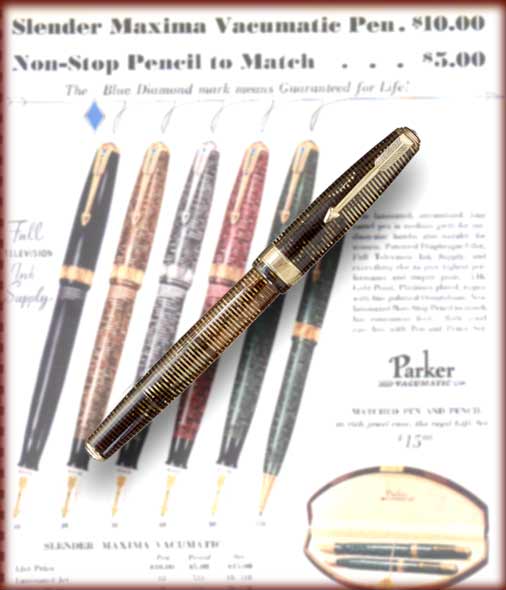
The Parker Vacumatic fountain pen is quite popular with collectors of vintage pens. This series has all the right features to appeal to the potent obsessive-compulsive tendencies that fuel most great collections. Many nice Parker Vacumatic pens still exist due to both the high quality and commercial success of the series. They are beautiful fountain pens. They had a long run- from 1932 (counting pre-vacs) through 1948 in the USA. Numerous colors, models, and style variants exist. One can find examples spanning a wide range of prices. Some models (unrestored) can be acquired for < $50 without great difficulty, allowing the beginning collector entry to this series. Other examples might require years of hunting and thousands of dollars to procure, thus maintaining interest for the advanced collector. Once one accounts for styling tweaks, color varieties, some odd non-USA models, and "prototypes", the collector can pursue 750 pen and pencil variants from this series. And the number just keeps growing.....
In this essay, we discuss a particular model- the Parker Vacumatic Slender Maxima. This pen, a 2nd Generation Parker Vacumatic (1937-1941), is not a common model. Several other 2nd and 3rd Generation Parker Vacumatic pens share certain features in common with the Slender Maxima. This has led to both confusion and considerable discussion about what constitutes a "proper" or "true" Parker Vacumatic Slender Maxima. This becomes perhaps more important since the very name, "Slender Maxima" usually conveys an increased cachet to pens labelled as such. Perhaps we can shed some light on the subject.....

The Slender Maxima is a source of confusion to most collectors of the Parker Vacumatic.
Few items provoke as much controversy amongst dedicated collectors of the Parker Vacumatic as does the Slender Maxima model- a pen introduced during the 2nd Generation of the Vacumatic series.
Ask three collectors of the Parker Vacumatic what they believe constitutes a "correct" Slender Maxima, and you are likely to get four answers.
This subject crops up frequently on the world wide web. Whilst sitting around munching pizza at pen shows, aficianoados of the Parker Vacumatic debate the fine points. Often the answers remains unclear- too many conflicting opinions float about. The Slender Maxima can be a pain.
One might expect that this model *should* be defined quite easily; it is a 2nd-Generation Parker Vacumatic that is as long as a Vacumatic Senior Maxima but as thin as a Major/Junior pen, that features a Maxima-style cap-band and that has a larger-than-Major nib. That is what Parker advertised as the Slender Maxima. But it is not this simple. Several other Parker Vacumatic models share features in common with this pen.
Before we delve into the subtleties of what is or is not a true Parker Vacumatic Slender Maxima, it behooves us to view at least one pen about which no one will argue. This is the model Parker sold as the Slender Maxima and which meets all the criteria for a classically correct slender maxima:
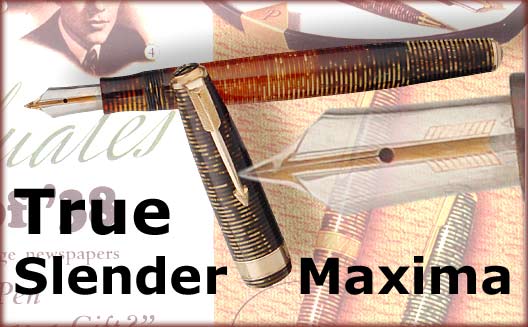
Let us consider the typical features of a true, proper Parker Vacumatic Slender Maxima.
Let us compare the typical nib of the Vacumatic Major to that of the Vacumatic Slender Maxima and the Vacumatic Senior Maxima. Without practice, one has difficulty recognizing the subtleties of nib sizing. Nibs can seem larger if they are inserted a shorter distance into the pen's Gripping Section; more of the nib shows. A nib can seem wider if it is wrapped more loosely around the feed.
But the Vacumatic M ajor has a nib markedly different from that of the Slender Maxima. Not only is the nib shorter (notice below the distance from the nib tip to the "parker usa" imprint"), but the "arrow" imprint on the Major has different proportions. On the Slender Maxima or Senior Maxima, proximally to the breather hole, the "arrow" imprint has a longer arrow shaft and feathered area.. The Major has a shorter feathered end. The Major nib seems point-heavy. The two sizes of Maxima have nibs that seem "feather heavy".
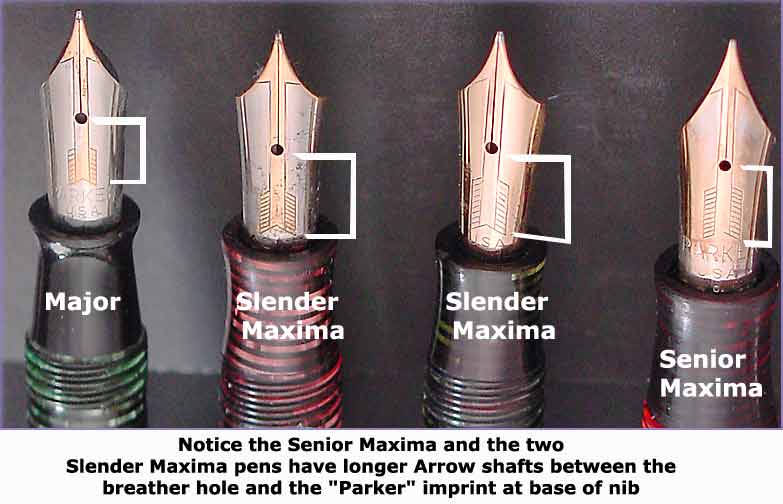
Causing confusion, several other models of Parker Vacumatic fulfill some of the "Slender Maxima" criteria- they *are* as long as the Senior Maxima and thin like the 2nd Generation Major/Streamlined Standard/Junior. However, these other models lack certain features of the Slender Maxima, at least as the Slender Maxima was advertised by Parker. The differences focus largely on the cap-band style and the nib.
It is my belief that none of these other pens should be considered a Slender Maxima. Others will disagree. But, if this were simple, it wouldn't be so much fun.
These other models include Vacumatics that likely were sold as Major, streamlined Standard, Jeweler's Band Major, and -sigh- even some late 3rd Generation Vacumatic Junior pens of Canadian origin and of unusual cap and barrel length. All of them have cap and barrel proportions like that of the Slender Maxima.
Below, we can examine five such pens bracketed on the left by a true Slender Maxima, on on the right by a larger-diameter Senior Maxima
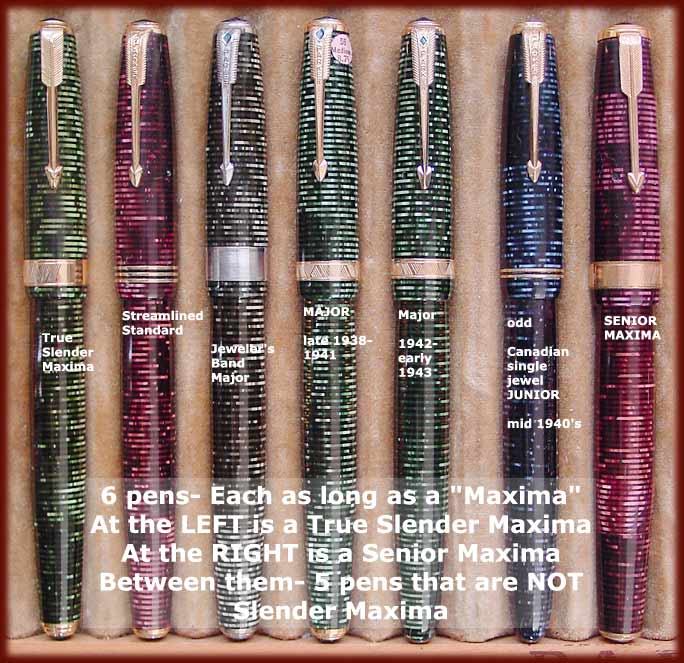
Let us examine reasons for confusion and for conflicting opinons....
First. In the absence of, say, dedicated technical diagrams from Parker itself, we have few "pure" forms of information as to Parker's "original intent" about much of anything. Many data are available; most suffer from artistic license. Catalogs , ParkerGrams and Advertisments are useful, but they are not perfect. Even price stickers on pens sometimes inaccurately represent a given model pen.. It is beyond the scope of this article to address those imperfections. Still, even now many collectors graciously provide useful scraps of original Parker data to help clarify the lore of the Parker Vacumatic.
Second. The Slender Maxima made its appearance during an era marked by a flurry of evolution of Vacumatic models and trim styles. This adds to the challenge of identifying models in retrospect. The complicated changes during 1939 - affecting clip, section, and barrel jewel- are beyond the scope of this article.
Third. Parker had a habit of tinkering with the nomenclature of its pen models. Over time, some models received new names for essentially the same pen. Conversely, the same name was sometimes applied to different models of pen. This complicates analysis of the 2nd generation of the Parker Vacumatic and does affect the Slender Maxima. Here is an example showing different model names in 1938 and 1939 for the small Shadow-Wave pattern Vacumatic. Most collectors, including this author, prefer to use one name for most models, at least in general conversation. I prefer the "Junior Debutante" appellation for the model pictured below.
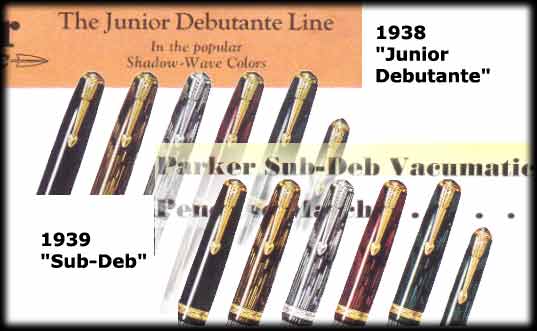
Even the pen that relative purists call Slender Maxima had two different names prior to Parker naming it the Slender Maxima, per se. When introduced, Parker briefly advertised it as the "Speedline Maxima" and for a longer period simply as the "Maxima". No joke. To confuse collectors further, the larger-diameter pen known at first as Senior Maxima itself would be renamed Maxima in 1941. Thus, a 1937 Maxima (Slender Maxima) is a markedly different pen from a 1941 Maxima (Senior Maxima), yet modern collectors can honestly call both pens simply Maxima, depending on the year of manufacture of the pen. It is perhaps appropriate in casual conversation to avoid calling the thinner pens simply "Maxima", even if technically correct to do so..
Fourth. Evolution of Parker's hit model, the Vacumatic Major, brought its appearance quite close to that of the Slender Maxima. This is perhaps the largest source of confusion regarding the Slender Maxima. One must learn and accept that Vacumatic Major pens of different length were produced at different times. We thus find Major pens that are as long as the Slender Max and can find others (early double jewel Major and late Single Jewel Major) that are shorter.
This leads some collectors to consider the two sizes of Major to be two different models and to consider the longer style Major to be an actual Slender Maxima. But, this is not consistent with how the pens were sold by Parker. IF these longer Major pens really were sold as Slender Maxima, we must accept that NO pens were sold as Vacumatic Major from 1939-1942, since we will have assigned the Slender Maxima label to all Major Vacumatics produced during this era. This makes this author uneasy, as the Major was by far the more successful and popular model of the two. We will consider this issue in detail shortly.
Fifth. Honest philosophic disagreement amongst ethical collectors exists today regarding the proper *approach* to the naming of pens issued with such muddled nomenclature by Parker. If i may steal from the jargon of the medical profession, i will label the two disparate camps as Lumpers and Splitters.
Some collectors are "lumpers" or "generalists"- believing it is best to simplify nomenclature to avoid confusion. By this model, several different Parker Vacumatic pens with different trim and nibs all receive the name, Slender Maxima. That they perhaps were marketed as different pens by Parker during the 1930's-1940's, does not outweigh the perceived need to provide a coherent organization for current collectors . But, this author is not convinced this approach truly simplifies the analysis of the Slender Maxima.
Within the Lumper Approach, that a pen has the overall proportions of the Slender Maxima is enough to earn the name. Since this results in several pens of subtly different appearance receiving the Slender Maxima name, one must subsequently stratify various Slender Maxima styles regarding relative scarcity and desirability.
By this model, rather than finding pens such as the Slender Maxima, the Major, and the streamlined Standard, etc, we have a Slender Maxima with Maxima Band, Slender Maxima with Major Band, Slender Maxima with triple band, etc etc. When this approach is used, it is usually the pen I call the "true" Slender Maxima which proves most valuable of the many different "Slender Maxima" styles. Not a surprise. The pen truly sold by Parker as the Slender Maxima is more scarce than the wannabees.
I do lean away from this approach, though i can appreciate and respect it.
Other collectors are "splitters" or perhaps "purists" regarding Parker's original intent. It is their belief that we should identify pens as best we can in accordance with how they were manufactured and sold by Parker. I favor this approach when considering the Slender Maxima Vacumatic.
Given the complexity of the Parker Vacumatic series in general, most collectors use a bit of each approach, as a given situation requires.
Even the purists often accept some "lumping" of models in the name of simplicity. Whilst i am more a Splitter than Lumper, just a few lines earlier i suggested we use the name, Slender Maxima, in general conversation for the equivelent pens produced before 1939- the Speedline Maxima and the Maxima- in order to avoid confusion. This serves to lump under the same name, what are essentially the same pens sold in the same niche but at different times, in similar fashion to the Shadow-Wave example provided above. This is different from lumping under the same name, several different models sold at the same time as different models at different price points . But each of us must make his own decisions.
OK. Enough "Philosophy of Confusion 101". Let us look at the pens......
The Parker Vacumatic Major, in double-jewel trim, as it was produced from late 1938-1941, is the model most often confused with the Slender Maxima.
In mid-late 1937 Parker introduced 3 new models of Vacumatic, heralding the onset of the 2nd Generation of Vacumatic.
These pens included.....
1) The Major (briefly named Speedline Maxima during the 1937
introduction)
2) The Slender Maxima (called Maxima in 1937-1938 and called
Speedline
Maxima briefly during the 1937 introduction)
3) The Senior Maxima. (its name would change **to**
Maxima
by 1941)
These models would evolve into the "guaranteed" blue-diamond models in time. The smaller Debutante would appear at some point during 1938.
The Major essentially replaced (though they overlapped for a bit) the 1st generation deluxe series pen, the Standard- a more squarish earlier style pen of similar overall length. Both represented the high-line standard size pens from their respective eras.
The Slender Max sold for the same price as the Senior Maxima and was positioned as a feminine, thinner version of the most expensive Vacumatic. It was about 1/4 inch longer (closed) than a Major, had a wider band similar to that of the Senior Maxima and had a nib that was larger than that of the Major. The Slender Maxima nib had a longer arrow shaft logo. Compared to the early Major pens, the Slender Maxima had a lightly longer Cap and Barrel. But, the diameter of the Slender Max was identical to that of the Major. One can swap the caps- they will thread- but this will result in odd-length pens.
Apparently, the Slender Maxima pens did not sell very well- a speculation. They are not easy to find today. Far fewer of them show up on-line or at pen shows than do Senior Maximas. Perhaps the extra cost of the pen did not appeal to buyers who saw little difference between it and the major. Perhaps "feminine" buyers were more used to the notion of true slender pens, such as the deluxe line "Slender" or the slightly later "Debutante". Please feel free to email the author any other possible explanations.
But, had the split between Major and Slender Maxima remained this way, there would be little or no controversy today. The Parker Vacumatic Major would have the "Major" cap-band and would be a tad shorter than Slender Maxima and would have slightly smaller nib and that would be the end of it.
But, that is not the end of it.

By late 1938, Parker changed the size and style of a couple models. The Vacumatic Major began manufacture as a slightly longer pen. The cap and barrel length now matched that of the Slender Maxima, though the nib was still a bit smaller. Caps and barrels could now be swapped between the two models and not only fit in terms of barrel diameter, but also now produced pens of identical length.
So, by 1939 the length (cap, barrel, blind-cap etc) of a Parker Vacumatic Major was the same as that of a Parker Vacumatic Slender Maxima and as that of the Parker Vacumatic Senior Maxima- the latter being a fatter pen of course.
Note that this is an area of significant controversy. The 1939 Parker catalog still lists the Major as a "medium length" pen and lists the Slender Maxima as a "long-barreled pen". But the pens themselves had become the same size. Examination of literally hundreds of 1939-1941 Vacumatic Major pens confirms this.
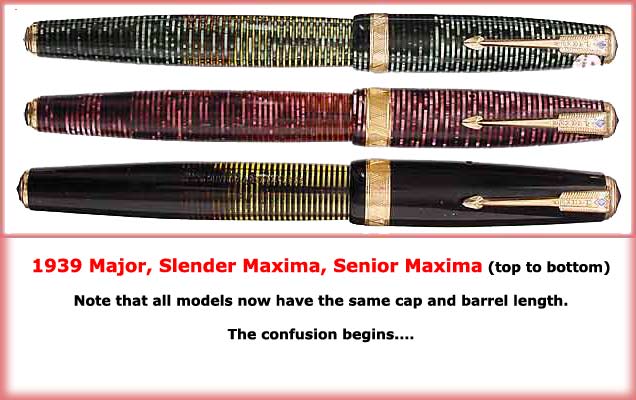
Why did Parker alter the Vacumatic Major to the same size as the same size as the Slender Maxima?
Dunno.
One can speculate. With the Slender Maxima perhaps selling poorly, it is not impossible that Parker opted to consolidate some of its production. Pens from both models could be produced from one set of parameters for Rod stock, with just the nib and cap-band separating the Vacumatic Major and Vacumatic Slender Maxima. Certainly, the appearance of other models of Parker Vacumatic during this time - also using these barrel and cap dimensions- would support this argument. But again, this is speculation. I have seen no related information in catalogs or ParkerGrams. Some collectors of course will disagree with the model outlined above. Still, i would be happy to see 1939-1941 Vacumatic Majors that maintain the shorter dimensions of the 1937-8 pens. I don't believe they exist (barring the occasional Parker oddity of course).
Several other Parker Vacumatic models also would appear with the same proportions as the Slender Maxima and as the newly longer Major.
One such pen is the Parker Vacumatic Streamlined Standard
In late 1938, about the time the Major changed, Parker altered one of its 1st generation Vacumatic models- the Standard. The Standard, often called Deluxe Standard since it was part of the 1st Generation high-line pens and was described as "Deluxe" in certain Parker catalogs, was a very popular model from 1933-1938, continuing sales with its earlier-style "lockdown filler" well into the start of the 2nd Generation. The pen featured the usual Vacumatic colors and a simple but elegant Triple cap-band.
During late 1938, Parker mutated the Standard into a 2nd Generation pen. In the 1939 Parker Catalog, the pen is referred to as a streamlined (adjective) Standard, though pictures show the older more chunky styled Standard. The Catalog picture is probably wrong. Few 1939 1st-gen Standards have been seen. But plenty of 1939, 1940 and perhaps 1941 streamlined Standards can be found. Collectors tend to incorporate the adjectival "streamlined" into part of the very name of this model and call it the Streamlined Standard (vs streamlined Standard), to recognize it as a somewhat different model from the 1st generation pen. Yes, in this case perhaps this author strays from the "VacPurist" path :-)
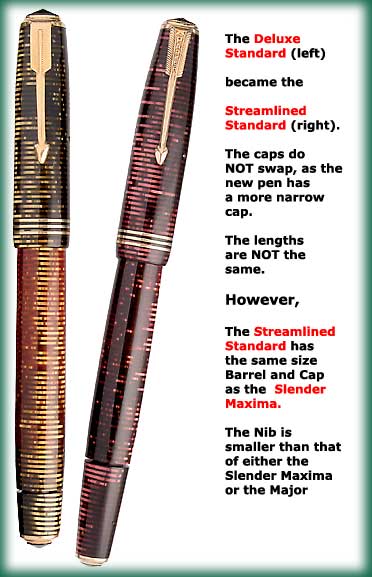 Care
to
guess the contour/shape Parker used for the Streamlined
Standard??
Care
to
guess the contour/shape Parker used for the Streamlined
Standard??
You guessed it. If not for the cap-band difference, nib difference (this pen features a Standard/Junior nib even smaller than that of the Major), the Streamlined Standard could pass for either of the other two Slender-Maxima length pens that we have seen so far (the Major and the Slender Maxima).
This pen, despite being the heir to the name of a 1st
Generation
high-line Vacumatic, was not a lifetime-guarenteed model. It thus
followed
the 1938-1940 clip evolution seen in the lower-line pens, such as
the Shadow
Wave Juniors. We should not call it a Slender Maxima.
Another Parker Vacumatic model produced in the proportions of the Slender Maxima was the Parker Vacumatic Major with "Jeweler's Band".
In (probably) 1939 Parker introduced a line of Vacumatic pens with an extra-wide cap-band featuring concentric stacked circles bracketed by a wider smooth edge. This cap-band is universally recognized by collectors as the "Jeweler's Band". It is factory issue. Pens with the Jeweler's Cap-Band are popular variants for collectors. The clouded history of the Jeweler Band is beyond the scope of this article.
It is unclear if parker used identical names for these models, used modified names (eg- "fancy" Major or "deluxe" Major or "Major with Jeweler Band) for equivelent models, or had a whole separate nomenclature for these pens. But most collectors today tend to address them as "Jeweler's Band" versions of whatever regular "catalog" model they most closely resemble.
The Jeweler's Band Vacumatic pens were produced in 4 sizes. The
largest
is a Senior Maxima pen. The smallest is like a little Debutante.
Two middle
sizes exist. One is about 5 - 5 1/8" long and looks very much like
a Vacumatic
Junior (right down to the nib size) save that it has the wider
band and
has a blue-diamond clip, signifying a guaranteed pen - which is
unlike
the non-Jeweler's-Band Junior. The Cap-Band on the
larger of
the two "middle sizes " is..... the same size as a Slender
Maxima,
as a 1939-1941 Major, as a 1939-1941 Streamline Standard.
This second-largest
pens (proportions of a Major and Slender Maxima) has a nib
the size
of a Major. Yeep!
Should this pen be considered a "Slender Maxima with Jeweler's Band"?. I will argue "NO", though this perhaps is the most arguable call in this essay.
But, this is the toughest exclusion of the bunch. And it is here that i take my chances to be pounded for taking a stand.
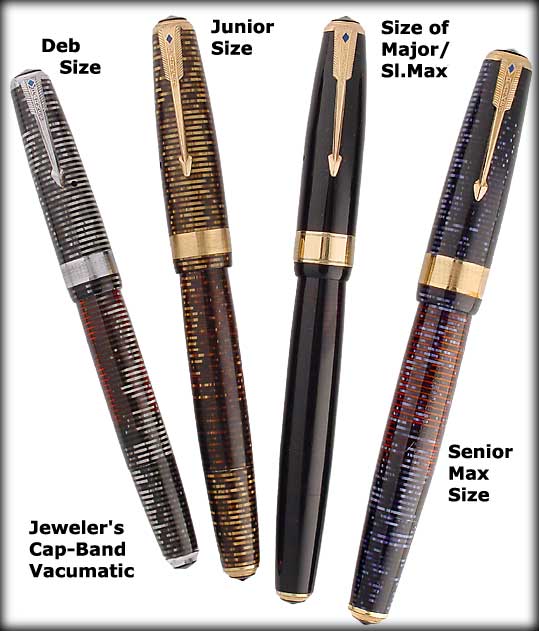
Unlike all the other pens which share proportions with the Slender Maxima, even some "purist" arguments can be made to call the Jeweler's Band pen of this size a Slender Maxima. Certainly the apparent lack of data from Parker itself regarding this model, leaves it more open to debate.
Let us play devil's advocate. The second-to-largest pen in this series is as long as a Senior Maxima (and the Slender Maxima and current Major and Steramlined Standard), and has the same Jeweler's cap-band as the Senior Maxima version of the Jeweler series- surely good arguments for calling it a Slender Maxima Jeweler's Band pen. In our discussion of catalog-correct Vacumatic models, one of our key criteria for the true Slender Maxima was that it have the same cap-band as the typical Senior Maxima. In the case of the odd Jeweler's series pens, this criterion is met-sort of- by the long/slender pen.
But, problems arise.
First. If we label the long/thin Jeweler's band pen above (third from left) a Slender Maxima, then we are again left with no "Major" in the Jeweler's series. Again, we should hesitate to use a naming system that renders the best-selling Major nonexistent. If any collector succeeds in finding some true Parker literature about these "Jeweler's-Band" pens, perhaps we will then put this controversy to rest.
Second. The shorter, 5-5.125" Jeweler's band pen (second pen from left in the big picture, and cap-band #2 in the cap-band picture) is the same size as a 1939-1941 Junior (itself a standard-size 5"-or-so pen), and has a Jeweler's cap-band that is the same width as that of the small, ladies' pens, the the Debutante. We probably should *not* argue that this is really the "Major with Jeweler's Band" and thus elevate pen #3 to Slender Maxima status, because the typical Major from this period is longer than this pen (2nd from left) and because this pen shares a cap-band size with the smaller Debutante size pen.
Third. The long/thin Jeweler's Band pen (the cap-band is
shown
in item #3 in the both pics) consistently has a Major-sized nib. I
have
seen about 40 pens of this size with this cap-band. None have the
Slender
Maxima nib. This argues against calling this pen a Slender Maxima
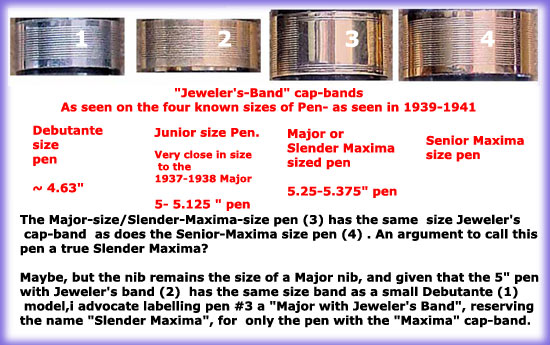
The Jeweler's Band pens are neat pens, and are not shown in typical Parker catalogs. Given that the conventional Major and Streamline Standard of 1939-1941 are also as long as the Senior and Slender Maxima, and given that the 4 sizes of Jeweler's band pens seem to parallel the 1) Debutante, 2) Junior, 3) Major/Streamlined Standard/SlenderMaxima and 4) Senior Maxima sizes, i believe it is best to call even the long Jeweler-band pen, simply a Major with Jeweler's Band.
Clearly, data are lacking on this point. I hope to find
Parker
literature about this model, or at least spot a few Mint-stickered
examples
at some point. Comparing the model codes on such pens with known
model
codes for conventional Vacumatic pens, might yield some insight
into this
issue. I did see one stickered pen couple years back, before i was
familiar
with model codes. I believe it had an odd model-code,
different from
those seen on typical Vacumatic pens. You will also note i
did not
address what we perhaps should call Pen #2 (Junior size but
lifetime markings).
The details of that discussion will have to await another day
Is that it for long pens that are not Slender Maxima?
Well, no.
To move further, we will need to move briefly beyond the 2nd Generation of Parker Vacumatic, and step into the 3rd Generation, 1942-1948.
Let us consider the Single Jewel Vacumatic Major- "first year" edition.
One can find certain Parker Vacumatic pens often referred to as Single Jewel Slender Maxima. They are not that, though. As you know, single jewel pens are 3rd Generation pens produced in the USA from 1942-1948. Parker, during that era, eventually returned the Major to the size similar to what it had been in 1937-early 1938, which also matched the size of the Vacumatic Junior of late 1938-1948). This means that the Major, which was produced as a larger pen from late 1938- very early 1943, became a shorter pen again in 1943.
But, some Single Jewel Majors have the same proportion as the longer late 1938-1941 double jewel Vacumatic Major pens and thus of course also have the same proportions as the true Slender Maxima. In fact, these pens are the same length as all the long pens we just discussed- the Slender Maxima and the Slender Maxima wannabees. Yet, Parker stopped advertising any Slender Maxima by the end of 1940. The Slender Maxima is not even in the 1941 Catalog- which proves nothing but is worth noting.
Please consider one more issue which creates further confusion about this particular model. With the introduction of the Single Jewel pens in 1942, even he larger "Senior" Maxima lost the classic Maxima Cap-band, at least in the USA. USA-produced single-jewel (Senior) Maximas have a thinner cap-band, identical to the Major cap-band save that it is on the wider-diameter pen. Details of this will await another essay. Unfortunately, this does mean that the long single-jewel Major from 1942 does have the same cap-band as the Maxima (Senior Maxima) from 1942. Still, even though this long thin pen technically has the same cap-band as the Maxima from that era, we should *not* consider this single jewel long thin pen to be Slender Maxima. Rather, it really is the Vacumatic Major
So, IF parker stopped the Slender Maxima in 1940, and IF most single Jewel mid-1940's Vacumatic Major pens are shorter again like the 1937-8 Major pens, and IF even true (Senior) Maxima sized pens feature a "Major" style cap-band, then what is the story with the "long" single Jewel pens with Major Band??
Did Parker produce some Slender Maxima pens again during the Single-Jewel era? Were these sold in parallel with the new shorter Major? Was it a method to reduce old rod stock whilst producing the newer shorter major? Or did Parker just produce longer and shorter majors willy-nilly during the third generation??
The answer to these four questions is NO, NO, NO and NO.
The answer is that these long single Jewel pens are essentially "First Year Single Jewel Major" pens. You will find (with rare exception) that these longer 1-Jewel pens have date codes for 1942 or early 1943 (1943 with three dots). The shorter, more common single-jewel Majors date later. No apparent overlap exists. It is my belief, that while the introduction of the 1-Jewel pens marked a period of consolidation of models for Parker, that not all the consolidating happened at once. Rather the longer style Major was produced through early 1943, and only then was it reduced in size to the more commonly seen short Major. Again, these pens have Major-size nib. One can of course, make his own short 1942 "short major" by taking the cap of a 1943+ Major, and the barrel of a 1942 Junior (essentially identical in size to later Major barrels) and putting the two together. I don't suggest doing this.
Of interest, many of these 1942 Majors, still demonstrate features of the earlier 2nd generation pens: two-tone nibs, striped top jewel, occasionally even a metal filler unit. But these are pens still are not Slender Maxima
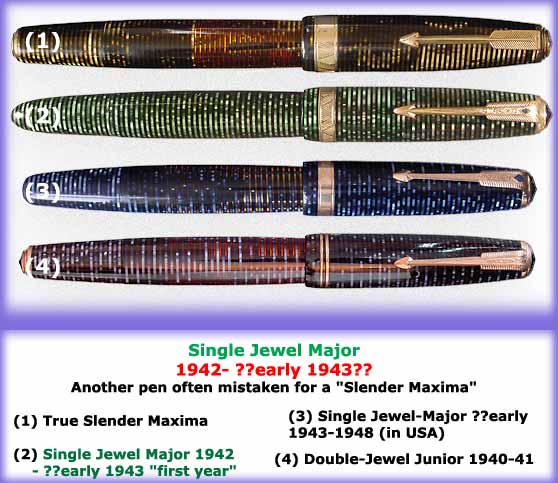
So, is that it?? Is there anything more out there that is as long as a Slender Maxima than the Slender Max itself, the long 2-jewel Major, the Streamlined Standard, the Major with Jeweler's Band, and the 1-Jewel first year Major???
Well, yes.
One last Slender Maxima Wannabee- The atypical, extra long Canadian single-jewel Parker Vacumatic JUNIOR.
Let us move north to Canada. Parker Canada didn't always follow the rules.
A common and popular Vacumatic produced during the 3rd Generations was two- cap-band Vacumatic Junior . It was produced in the USA from 1942-1948 at the 5-5.125" size that marked the early (1937-8) and late (1943-1948) Major pens and that marked the similar double-jewel 2nd Generation Juniors as well. 99.9% of Juniors have shorter cap and barrel proportions than does the Slender Maxima.
Apparently, some longer pens similar to first year single-jewel 3rd generation Major pens, were produced in Canada . This leads to the reality that one can even find two-cap-band non-guarenteed pens that are as long as Slender Maximas.
These are not "cap swaps" between typical Junior and longer-barreled earlier Major. The cap itself is at least as long as a Slender Maxima cap.
Some of these Canadian Juniors are even longer than typical True Slender Maxima pens. Go figure. Interestingly, i have never seen a 2nd generation Double Jewel Canadian Junior that had longer-than-expected proportions. All seem to be 3rd Generation Single Jewel pens.

And that ends the list of non Slender Maxima Parker Vacumatic pens often mistaken for the Slender Maxima.
We have examined five such pens.
Let us review the cap-bands of the Slender Maxima, the five not-quite Slender Maxima pens, and the wider-diameter Senior Maxima
Review Picture.
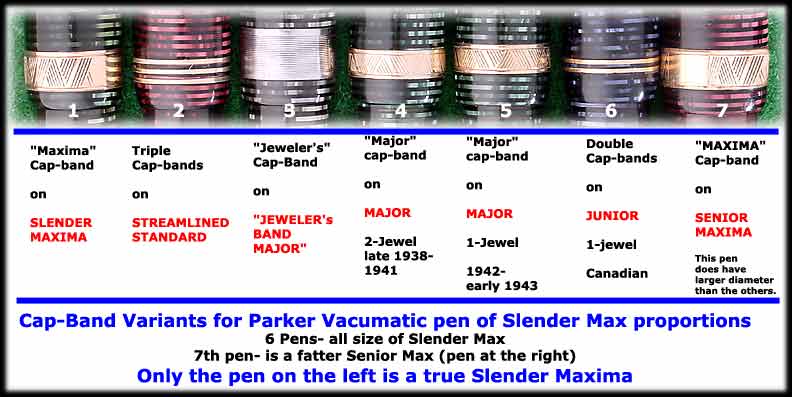
We begin to draw to a close
You have seen that several models of the Parker Vacumatic Fountain pen share barrel length, cap length and diameter with the model known as the Slender Maxima. We have discussed the context in which these models appear. We have noted that collectors have varied beliefs about whether these similar-size pens should be considered Slender Maxima. We have seen the "catalog-correct" pen which indisputably is the Slender Maxima.
Is it "wrong" to call these other pens, "Slender Maxima"?
I consider it inaccurate to do so.
Certainly, regarding several other Parker Vacumatic models, i have been willing to use "inexact" names to minimize confusion. But, the Slender Max- the real one- is a fairly scarce Vacumatic. Ignoring the special Imperial and Imperial Signet series of Vacumatic, the Slender Maxima, along with the Senior Maximx was the most expensive Vacumatic of the 2nd Generation. Some of the other pens under discussion were not even "guaranteed" or "life-time" or "high-line" pens. We should not consider them to represent the Slender Maxima.
The pen most commonly mislabelled as Slender Maxima is the venerable Vacumatic Major- the longer variants from late 1938 perhaps to early 1943, spanning the 2nd and 3rd Generations. But the Major was a very popular model in its time. It sold well. If we decide these long-variant Majors are to be called Slender Maxima, then we would have to suggest that NO Vacumatic Major pens were produced from 1939-1942, because pretty much every Major produced during those three years is as long as a Slender Maxima.
I am uncomfortable carrying the lumping of pen models to the point that we decide Parker produced "none" of one of its best selling models simply because we prefer to ascribe to that model, the name of a more scarce pen that carries increased cachet- even if this is easier for collectors. . That is my personal choice in this matter. I respect that people might disagree.
In summary, the caps, barrels and blindcaps of at least 5 other models of Parker Vacumatic fountain pen, can exchange to make pens of similar proportions. Yet these other models should not be considered to be the uncommon Slender Maxima. Amongst these models, limitations on available date allow that the Jeweler's Cap-Band Major perhaps can make the strongest argument to be considered a Slender Max of sorts. But, in view of all the not-quite Slender Maximas out there, i believe it best to limit this model name to the pen advertised as such by Parker, the one that shows the typical "Maxima" cap-band as pictured below.
Great stuff, the Parker Vacumatic. All this information discusses just one of many persnickity questions which challenge collectors of the Parker Vacumatic. Someone oughtta write a book. This essay covers but 2% of the material.
Before we call it a day let us view a (probably) complete "color" set of the Parker Vacumatic Slender Maxima. Does the Azure Blue Slender Maxima exist? Vacquiring minds want to know.
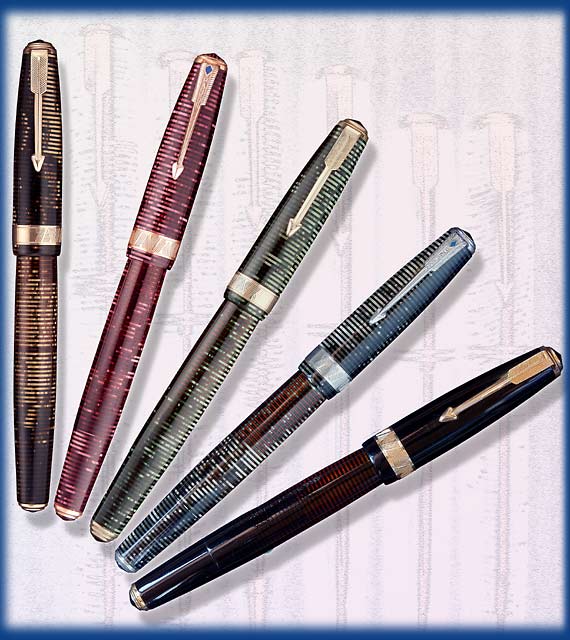
If anyone has any comments or constructive criticism, please direct to either that Riepl fellow or to the author at isaacson@frontiernet.net. Look for more vacumatic information at my website www.vacumania.com
Thanks, and good hunting!
David